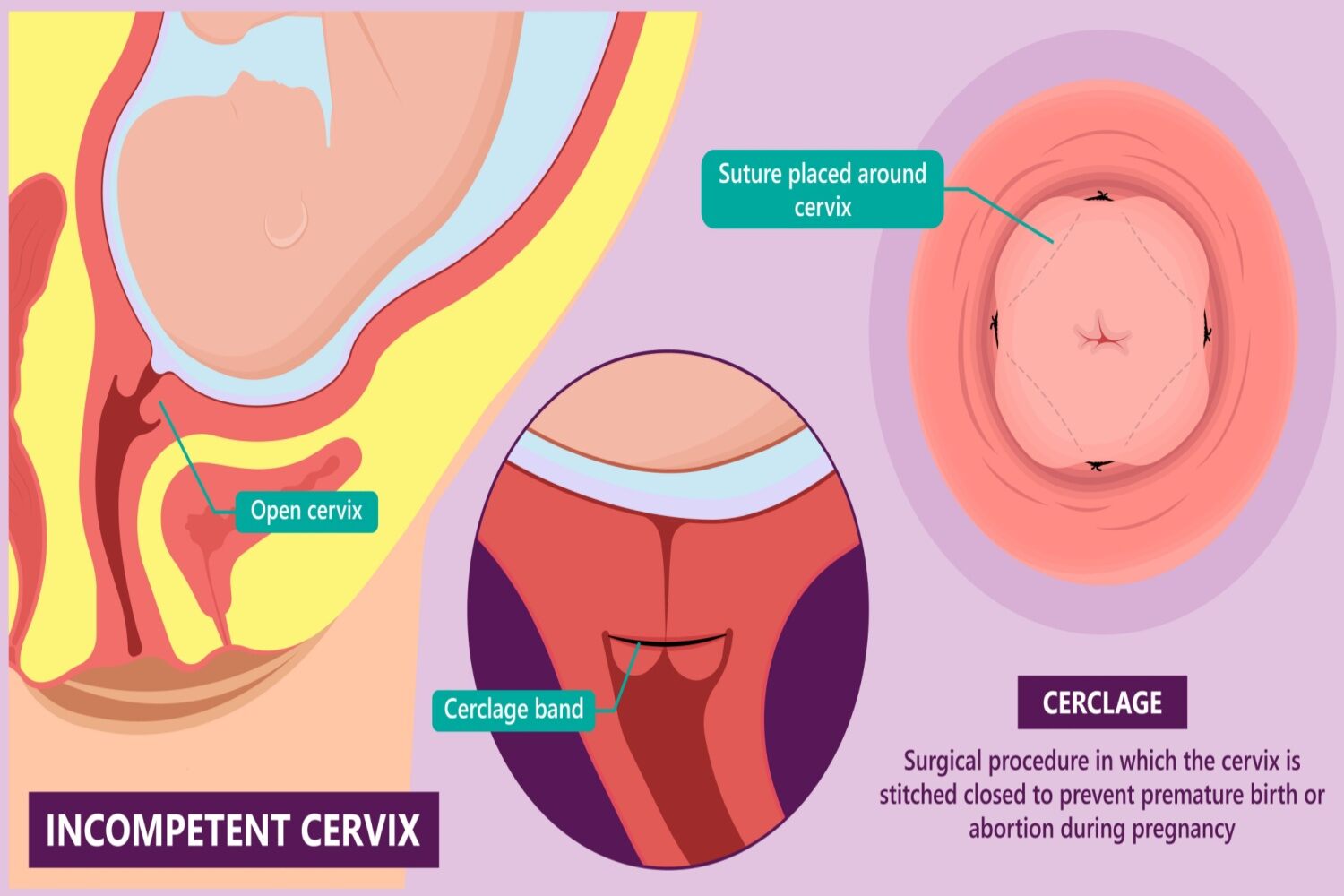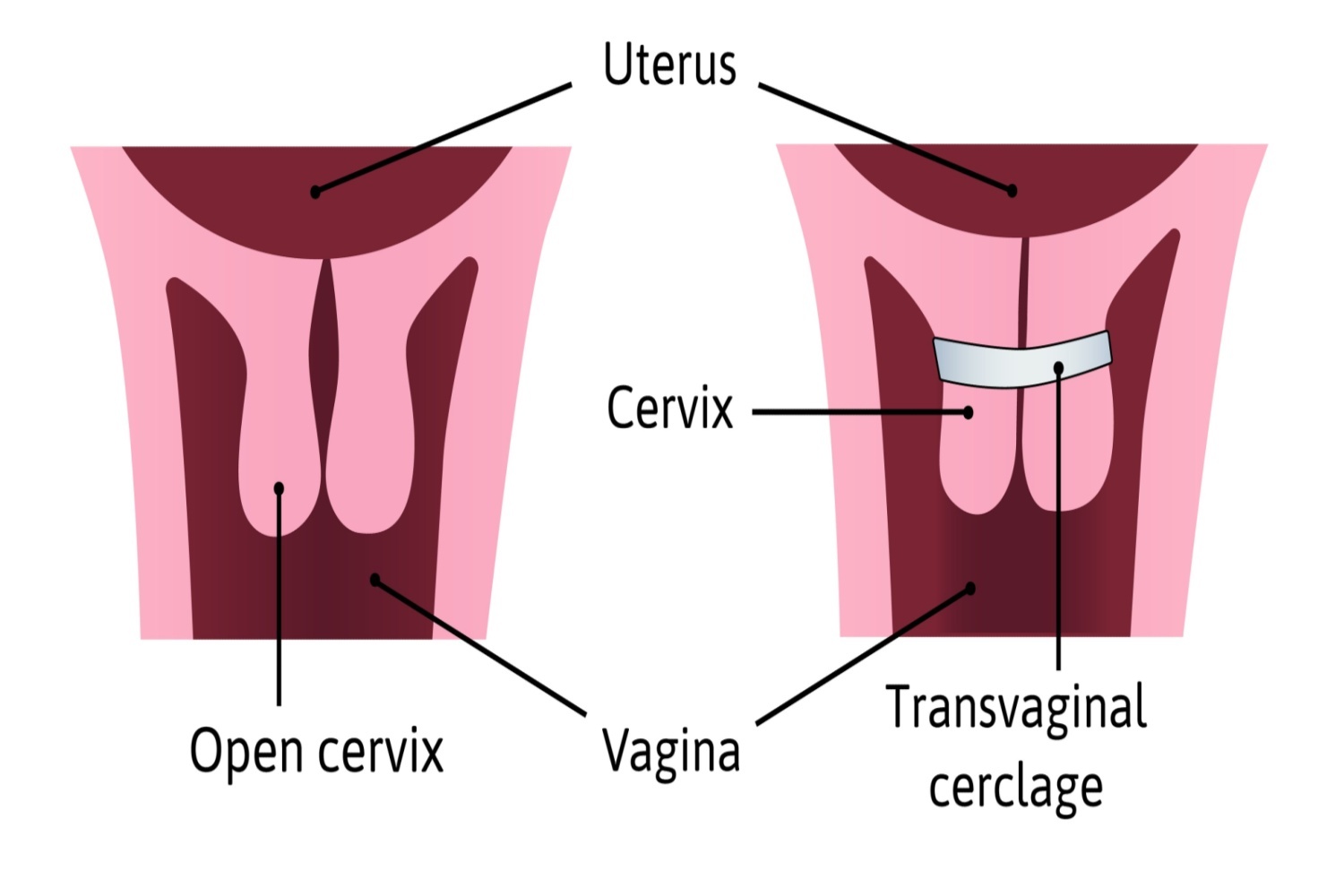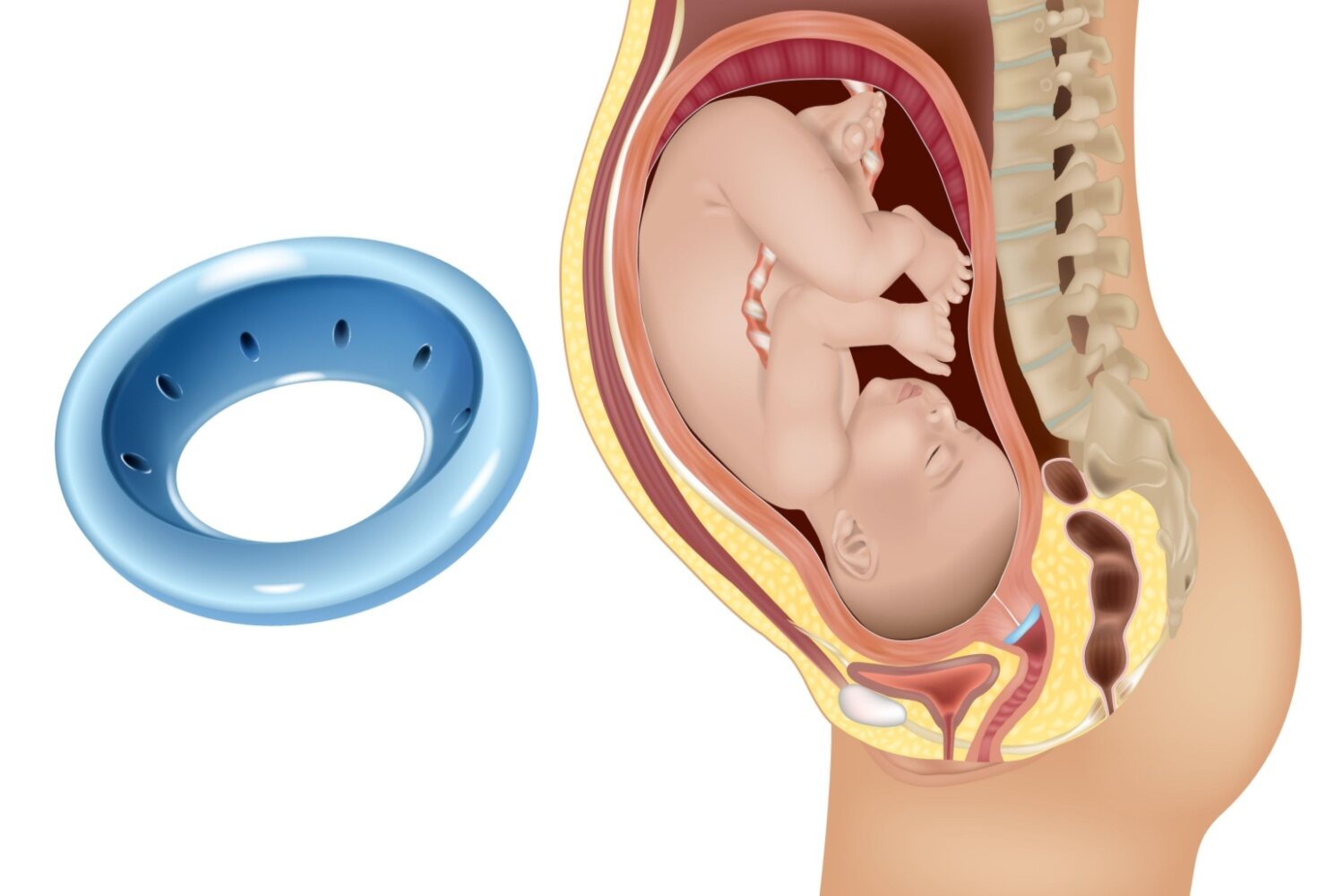 Approximately 10% of pregnancies nowadays ends in premature delivery. There is 3.3 times more possibility for a pregnant woman to undergo premature labor if she has an incompetent cervix. A narrow neck-like passage that forms the uterus’s lower part and extends to the vagina is called the cervix.
Approximately 10% of pregnancies nowadays ends in premature delivery. There is 3.3 times more possibility for a pregnant woman to undergo premature labor if she has an incompetent cervix. A narrow neck-like passage that forms the uterus’s lower part and extends to the vagina is called the cervix.
If a pregnant woman’s cervix is weak, it starts to widen and thins out before the pregnancy reaches full term, unlike the dilation and effacement that occurs in response to uterine contractions in a normal pregnancy. Therefore, a weak cervix can cause pregnancy loss or can lead to preterm birth. Cervical cerclage is the procedure that helps to prevent the consequences due to cervical weakness. Here is all that you need to know about this procedure.
In This Article
- What Causes Incompetent Cervix?
- What Is Cervical Cerclage?
- What Are The Types Of Cervical Cerclage?
- Why Is Cervical Cerclage Performed?
- How To Prepare For The Cervical Cerclage Procedure?
- Advantages Of Cervical Cerclage Procedure
- When Can A Cerclage Be Placed?
- What Happens During The Cervical Cerclage Procedure?
- What Can I Expect After The Procedure?
- How Long Is The Cerclage Stitch Left In?
- What Are the Risks Associated With Cervical Cerclage Procedure
- What Is The Success Rate Of Cervical Cerclage?
- Alternatives To The Cervical Cerclage Procedure
- When Is A Cervical Cerclage Not Recommended?
- FAQ’s
What Causes Incompetent Cervix?
A weakened or incompetent cervix can be caused by any of the following conditions:
- Previous surgery on the cervix
- Abnormalities of cervix or uterus from a birth defect
- Previous trauma to the cervix, such as a D&C and abortion during the second trimester
- A wrongly conducted abortion can damage the cervix permanently
What Is Cervical Cerclage?
 It is a small surgical procedure in which a suture is placed around the incompetent cervix during pregnancy to prevent it from opening due to any pressure as the pregnancy progresses. Most often, the women who need a cervical cerclage in one pregnancy will require it in successive pregnancies [1,2].
It is a small surgical procedure in which a suture is placed around the incompetent cervix during pregnancy to prevent it from opening due to any pressure as the pregnancy progresses. Most often, the women who need a cervical cerclage in one pregnancy will require it in successive pregnancies [1,2].
What Are The Types Of Cervical Cerclage?
There are basically 3 types of cervical cerclage. They are:
McDonald Cerclage
During this procedure a thick band (5 mm) of permanent stature is placed on the upper part of cervix while there is effacement in the lower part of the cervix McDonald cerclage is generally placed between the 16th to 18th weeks of gestation and is removed at the 37th week of pregnancy. This procedure is not known to cause any hindrance with vaginal delivery
Shirodkar Cerclage
This procedure is similar to McDonald cerclage but here the stitch pass through the cervix wall so they are not uncovered. This is not a very common procedure and is more difficult to perform than McDonald cerclage but it is known to reduce any kind of infection risk. Shirodkar cerclage sometimes involves the use of permanent stitch to tie the cervix and is left on for a lifetime. Here a C-section delivery becomes imperative
Trans abdominal Cerclage
This is the most uncommon type of cerclage and is permanent in nature. In this procedure, a band is placed at the very top and outside of cervix, inside the abdomen. It is performed when the cervix is very short to perform other types of cerclage or there is a failure of vaginal cerclage. Since this is a permanent procedure, a C-section is required for childbirth
Why Is Cervical Cerclage Performed?
Cervical cerclage is performed to prevent cervical insufficiency, which can lead to premature cervical dilation and preterm birth. It is typically recommended for individuals with a history of preterm birth or cervical insufficiency in previous pregnancies, as well as those with certain anatomical or medical risk factors that increase the likelihood of cervical weakness. By reinforcing the cervix with a cerclage, the procedure aims to support the cervix throughout the pregnancy and reduce the risk of premature delivery [1].
How To Prepare For The Cervical Cerclage Procedure?
To prepare for a cervical cerclage procedure, your healthcare provider may recommend the following steps [1]:
1. Medical History Review
Your healthcare provider will review your medical history, including any past pregnancy complications or cervical surgeries, and perform a thorough examination of your cervix using a speculum or transvaginal ultrasound. .
2. Follow Doctor’s Instructions
Your doctor will provide specific instructions, such as fasting before the procedure or avoiding certain medications. Your provider may advise you to avoid sexual intercourse for a week before the procedure.
3. Transportation Arrangements
Plan for someone to drive you to and from the hospital on the day of the procedure.
4. Anesthesia Discussion
Talk to your doctor about anesthesia options available for the procedure.
5. Ask Questions
Don’t hesitate to ask any questions or express concerns you have about the procedure to your healthcare provider.It’s normal to feel anxious, and your provider is there to address your concerns.
Advantages Of Cervical Cerclage Procedure
 Cervical cerclage, a surgical procedure to reinforce the cervix, offers several advantages in high-risk pregnancies [2].
Cervical cerclage, a surgical procedure to reinforce the cervix, offers several advantages in high-risk pregnancies [2].
Preventing Preterm Birth
Cervical cerclage helps prevent premature cervical dilation, reducing the risk of preterm birth and its associated complications.
Supporting Cervical Strength
By providing additional support to the cervix, cerclage helps maintain cervical integrity and reduces the likelihood of spontaneous opening during pregnancy.
Improving Pregnancy Outcomes
Cerclage can improve pregnancy outcomes for individuals at high risk of cervical insufficiency or preterm birth, leading to longer gestation periods and healthier babies.
Reducing Pregnancy Loss
For individuals with a history of pregnancy loss due to cervical insufficiency, cerclage can help reduce the risk of recurrent pregnancy loss by supporting the cervix throughout pregnancy.
When Can A Cerclage Be Placed?
Usually, cervical weakness will be detected during the routine tests conducted in the first trimester itself. The most appropriate time for the cervical cerclage procedure is during the 3rd month, usually between the 12th and 14th weeks of gestation (elective cerclage). There may be cases where some pregnant women may develop cervical weakness during later stages of pregnancy. They will require a cervical cerclage which is known as an emergent cerclage and the procedure is performed after the cervix has already started to open up.
What Happens During The Cervical Cerclage Procedure?
The doctor administers general, spinal or epidural anesthesia to the pregnant women to manage the pain during the procedure. The doctor will stitch a band consisting of strong thread around the cervix. This thread will be tightened to firmly close and hold the cervix together.
What Can I Expect After The Procedure?
After the procedure, the pregnant woman will be kept under observation either for few hours or overnight in the hospital to look for any symptoms of preterm labor. The pregnant woman might be advised bed rest and avoid any kind of physical activity for couple of weeks. A regular follow-up is necessary with the doctor to monitor the stitch and look for any signs of premature labor. Doctor will prescribe medicine to avoid any kind of infection or preterm labor
Immediately after the procedure, a pregnant woman might notice light bleeding and experience mild cramping which is normal and should go away in few days. A pregnant woman will also notice thick vaginal discharge which will continue until the end of the pregnancy
How Long Is The Cerclage Stitch Left In?
Generally, the cervical cerclage is removed at the 37th week of pregnancy. But it can be removed earlier if the water breaks or if the pregnant woman experiences contractions.
What Are the Risks Associated With Cervical Cerclage Procedure
 Cervical cerclage is a life-saving procedure. Therefore, the necessity outweighs the possible risks involved in this procedure. After the cervical cerclage, about 1-9 % of pregnant women are found to undergo premature delivery. Here are 8 possible risks associated with cervical cerclage:
Cervical cerclage is a life-saving procedure. Therefore, the necessity outweighs the possible risks involved in this procedure. After the cervical cerclage, about 1-9 % of pregnant women are found to undergo premature delivery. Here are 8 possible risks associated with cervical cerclage:
Infection
Chorioamnionitis, the amniotic sac infection, and the infection of the cervix can happen due to cervical cerclage. Specifically, if the cervical cerclage is conducted during the second trimester, the chances of chorioamnionitis is doubled. Some pregnant women also experienced yeast infection after cervical cerclage
Premature contraction
If the infection is spread to upper genital tract, it can set off preterm contractions, which end in preterm labor
Cervical dystocia
Cervical dystocia refers to the mechanical obstruction of the cervix. The cervix cannot dilate normally as the labor progresses thereby complicating the labor. Cervical cerclage can cause cervical dystocia thereby necessitating a C- section
Cervical laceration
If the women get into the labor before removing cervical cerclage, cervical laceration (tearing of the cervix) can happen which increases the chances of excessive bleeding
Chances of bladder injury
Sometimes the strong pressure is applied to the cerclage to remove it if it is covered by tissue. Trying to remove the cervical cerclage like this can result in bladder injury. Though this is a rare occurrence
Premature and preterm rupture of membrane
Premature breakage of amniotic sac can happen due to cervical cerclage
Cervical stenosis
This condition refers to permanent narrowing and closure of the cervix. This can happen as an after effect of cervical cerclage
Increase the chances of miscarriage
Infection and other complication that is associated with cervical cerclage can increase the chances of miscarriage
In addition to the above risks, all the risk that associated with local or general anesthesia is relevant to this surgical procedure too.
What Is The Success Rate Of Cervical Cerclage?
A cerclage is considered successful if the patient could able to hold the pregnancy for a full term, that is, for 37 weeks. The success rate of this procedure is about 80–90% in case of elective cerclage, and the success rate is about 40–60% for emergent cerclage.
Alternatives To The Cervical Cerclage Procedure
Usually, bed rest is the most appropriate alternative to cervical cerclage. It is usually advised to those pregnant women in whom the changes in the cervix are found very late in pregnancy or in cases where cervix has already opened up significantly.
When Is a Cervical Cerclage Not Recommended?
 It’s important to discuss individual circumstances and risks with a healthcare provider to determine the most appropriate course of action [3]. Cervical cerclage is not recommended in the following situations:
It’s important to discuss individual circumstances and risks with a healthcare provider to determine the most appropriate course of action [3]. Cervical cerclage is not recommended in the following situations:
Advanced Cervical Dilation
Cerclage may not be effective if the cervix is already significantly dilated (greater than 3 to 4 cm).
Active Labor
Cerclage placement is contraindicated during active labor.
Chorioamnionitis
In cases of chorioamnionitis (infection of the fetal membranes), cerclage placement is not recommended.
Later Gestational Age
Cerclage may not be as effective if performed at a later gestational age (typically beyond 22 to 24 weeks).
Overt Infection
Cerclage is contraindicated in cases of overt infection, such as intra-amniotic infection or inflammation.
Multiple Gestations
Cervical cerclage is generally not recommended in pregnancies with twins, triplets or more.
Cervical cerclage is a surgery used to avoid premature birth in pregnant women with weakened cervixes. By supporting the cervix throughout the pregnancy, it lowers the chance of an early birth and the associated problems. Although there are advantages, there are hazards as well, therefore it’s crucial to talk to a doctor. Alternatives like bed rest could be taken into consideration since not everyone may require it. Cervical cerclage can, in general, help pregnant women who are at risk have better pregnancies.
FAQ’s
1. Is A Cervical Cerclage Procedure Painful?
Cervical cerclage procedures are typically performed under anesthesia to minimize discomfort. Some individuals may experience mild discomfort or cramping afterward, which can usually be managed with pain medication.
2. What Things Should I Not Do After A Cervical Cerclage Procedure?
After a cervical cerclage procedure, it’s important to avoid strenuous activities, such as heavy lifting or vigorous exercise, to prevent putting pressure on the cervix. Refrain from sexual intercourse until your healthcare provider gives clearance, and attend all follow-up appointments to ensure proper healing and monitor for any complications.
3. What Precautions Should Be Taken During Cervical Cerclage?
During a cervical cerclage procedure, doctors ensure cleanliness and provide anesthesia for comfort. They carefully place the cerclage and give instructions to avoid straining the cervix afterward. Monitoring for complications is important for early intervention if needed.
4. What To Expect When You Have A Cervical Cerclage?
After a cervical cerclage procedure, you may experience minor discomfort or spotting, which usually resolves within a few days. Your healthcare provider will provide guidance on post-procedure care, including instructions on rest and restrictions on certain activities. Additionally, regular follow-up appointments will be scheduled to monitor the cervix and assess the effectiveness of the cerclage in preventing preterm birth.
5. How Long Should You Rest In Your Bed After Cervical Cerclage?
It’s typically recommended to rest in bed for about 24 to 48 hours after a cervical cerclage procedure to allow for proper healing. Your healthcare provider will provide specific guidance based on your individual circumstances.
References –
- Cervical Cerclage
https://www.ncbi.nlm.nih.gov/books/NBK560523/ - Cervical Cerclage
https://www.acog.org/womens-health/faqs/cervical-cerclage# - Emergency Cerclage: Outcomes, Patient Selection, and Operative Considerations
https://pubmed.ncbi.nlm.nih.gov/27101238/

